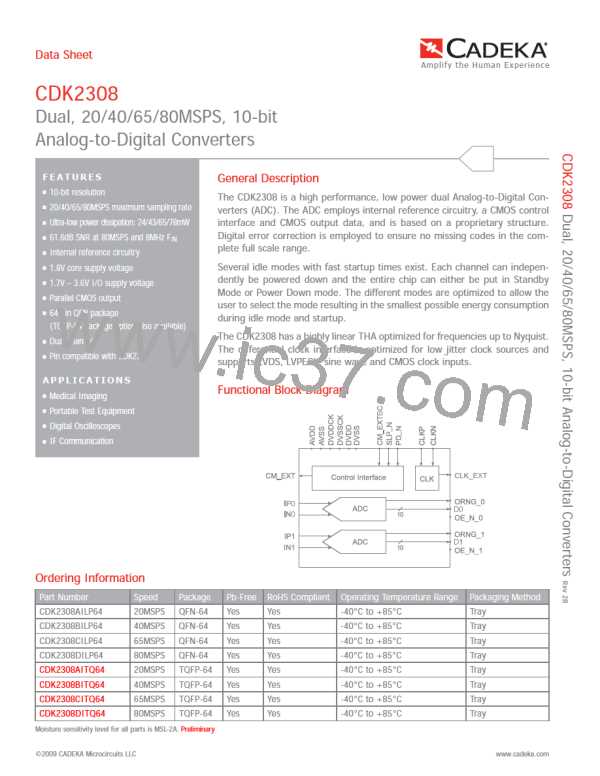Data Sheet
The quality of the input clock is extremely important for The CDK2308 employs digital offset correction. This means
that the output code will be 4096 with the positive and
negative inputs shorted together(zero differential). How-
ever, small mismatches in parasitics at the input can cause
this to alter slightly. The offset correction also results in
possible loss of codes at the edges of the full scale range.
With “NO” offset correction, the ADC would clip in one
end before the other, in practice resulting in code loss at
the opposite end. With the output being centered digitally,
the output will clip, and the out of range flags will be set,
before max code is reached. When out of range flags are
set, the code is forced to all ones for over-range and all
zeros for under-range.
high-speed, high-resolution ADCs. The contribution to SNR
from clock jitter with a full scale signal at a given frequency
is shown in equation 1.
•
•
•
•
SNR
= 20 log (2 π F εt)
jitter
IN
where F is the signal frequency, and εt is the total rms
IN
jitter measured in seconds. The rms jitter is the total of all
jitter sources including the clock generation circuitry, clock
distribution and internal ADC circuitry.
For applications where jitter may limit the obtainable per-
formance, it is of utmost importance to limit the clock jitter.
This can be obtained by using precise and stable clock refer-
ences (e.g. crystal oscillators with good jitter specifications)
and make sure the clock distribution is well controlled. It
might be advantageous to use analog power and ground
planes to ensure low noise on the supplies to all circuitry
Data Format Selection
The output data are presented on offset binary form
when DFRMT is low (connect to OV ). Setting DFRMT
SS
high (connect to OV ) results in 2’s complement output
DD
in the clock distribution. It is of utmost importance to avoid format. Details are shown in Table 1 on page 14.
crosstalk between the ADC output bits and the clock and
Reference Voltages
between the analog input signal and the clock since such
crosstalk often results in harmonic distortion.
The reference voltages are internally generated and buff-
ered based on a bandgap voltage reference. No external
decoupling is necessary, and the reference voltages are
not available externally. This simplifies usage of the ADC
since two extremely sensitive pins, otherwise needed, are
removed from the interface.
The jitter performance is improved with reduced rise and
fall times of the input clock. Hence, optimum jitter per-
formance is obtained with LVDS or LVPECL clock with fast
edges. CMOS and sine wave clock inputs will result in
slightly degraded jitter performance.
If the clock is generated by other circuitry, it should be
retimed with a low jitter master clock as the last operation
before it is applied to the ADC clock input.
Operational Modes
The operational modes are controlled with the PD_N and
SLP_N pins. If PD_N is set low, all other control pins are
overridden and the chip is set in Power Down mode. In this
mode all circuitry is completely turned off and the internal
clock is disabled. Hence, only leakage current contributes
to the Power Down Dissipation. The startup time from this
mode is longer than for other idle modes as all references
need to settle to their final values before normal operation
can resume.
Digital Outputs
Digital output data are presented on parallel CMOS form.
The voltage on the OV pin set the levels of the CMOS
DD
outputs. The output drivers are dimensioned to drive
a wide range of loads for OV above 2.25V, but it is rec-
DD
ommended to minimize the load to ensure as low tran-
sient switching currents and resulting noise as possible. In
applications with a large fanout or large capacitive loads,
it is recommended to add external buffers located close to
the ADC chip.
The SLP_N bus can be used to power down each channel
independently, or to set the full chip in Sleep Mode. In this
mode internal clocking is disabled, but some low band-
width circuitry is kept on to allow for a short startup time.
However, Sleep Mode represents a significant reduction in
supply current, and it can be used to save power even for
short idle periods.
The timing is described in the Timing Diagram section.
Note that the load or equivalent delay on CLK_EXT always
should be lower than the load on data outputs to ensure
sufficient timing margins.
The input clock should be kept running in all idle modes.
However, even lower power dissipation is possible in Power
Down mode if the input clock is stopped. In this case it is
important to start the input clock prior to enabling active mode.
The digital outputs can be set in tristate mode by setting
the OE_N signal high.
©2009 CADEKA Microcircuits LLC
www.cadeka.com
13

 CADEKA [ CADEKA MICROCIRCUITS LLC. ]
CADEKA [ CADEKA MICROCIRCUITS LLC. ]